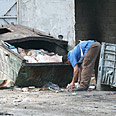
Searching the garbage for food
צילום: רונן בוידק
40% of Israeli children at poverty risk
Central Bureau of Statistics figures on socioeconomic change within Israeli society between 2003 and 2007 paint difficult picture. Israel is poorer, hungrier, and larger populations not seeking vital services, such as medical care. Gaps between Arabs and Jews are huge
More and more Israelis are poor, hungry, and abstain from seeking medical attention for themselves. This is the bottom line of the report published Monday afternoon by the Central Bureau of Statistics in honor of the International Day for the Eradication of Poverty. The report shows that 40% of children in Israel in 2007 were at poverty risk, as opposed to just 33% in 2001.
Risk of poverty is defined as belonging to a household with a disposable income per capita less than 60% of the national median equalized disposable income.
Socioeconomic gaps are most sharply seen between Jews and Arabs. 27% of Jewish children are at poverty risp, while 73% of Arab children in Israel are at poverty risk. The rate of poverty risk for all the Arab population in Israel rose from 26% in 2001 to 30% in 2007. For comparison, the risk-of-poverty rate in EU countries remained around 15-16% between during this period.
Some 90% of households with only one adult are single-mother households. Thirty-six percent of these households are not at poverty risk.
Arabs in catastrophic situation
Between 2003 and 2007, the rate of young people foregoing food for economic reasons rose by 7% (from 14% to 21%). Some 23% of women reported they gave up food versus 18% of men. The rate of foregoing food for economic purposes in the ultra-Orthodox population was nearly double that of the secular population (30% as opposed to 15% respectively). The situation of within the Arab sector is the most severe. The rate of foregoing food within the Arab sector more than doubled between 2003 and 2007 (21% versus 50% respectively).
Among households with low per capita gross income (less than NIS 2,000, or $535, per capita), there was a 14% change in the rate of foregoing food, whereas the rate of foregoing food among households with high per capita gross income (more than NIS 4,000, or $1,070 per capita) remained static at 4%.
In 2007, only 53% of people above the age of 20 reported being able to cover their monthly household operating expenses (such as food, electricity, telephone, etc.). When broken down by sector, 56% of Jews and only 33% of Arabs above 20 years old reported being able to cover these expenses.
The report, entitled "The Face of the Society: Objective and Subjective Indices of Poverty and Social Exclusion", deals with eight societal parameters that paint a picture of Israeli society. These parameters are: social, economic, and employment hardship, poverty and social exclusion indices (in comparison with EU countries), welfare, education, health, transportation (including road accidents), law and order, and the environment. The report also deals with gaps between men and women in Israel.
Less people feel poor
In 2007, 52% of adults above the age of 20 needed medical attention. Seventeen percent of this group did not seek medical treatment because of economic difficulties. This is a 4% increase from 2003 figures.
In regards to feeling poor, the report found trends opposite than the statistical reality of poverty. In 2007, 28% felt poor versus 31% in 2003. More than 70% of those who felt poor gave up on sufficient cooling or heating of their home, supplementary health insurance, or dental work.
In 2007, 15% of employed persons above the age of 20 were unsatisfied with their jobs and 44% were unsatisfied with their salaries. Some 9% of all employed persons feared losing their jobs, but 54% of them estimated that they would be able to find another job at a comparable salary should they be dismissed. Some 50% of women were unsatisfied with their salary versus 40% of men.
European statistics on poverty risk are smaller by half of Israeli figures (15% versus 30% respectively in 2007). The number of large families in Israel is higher than the number of large families in Europe, and the number of wage-earners in such households is consistently smaller. This is the main contributing factor to the vast gap in poverty risk in Israel versus Europe.










